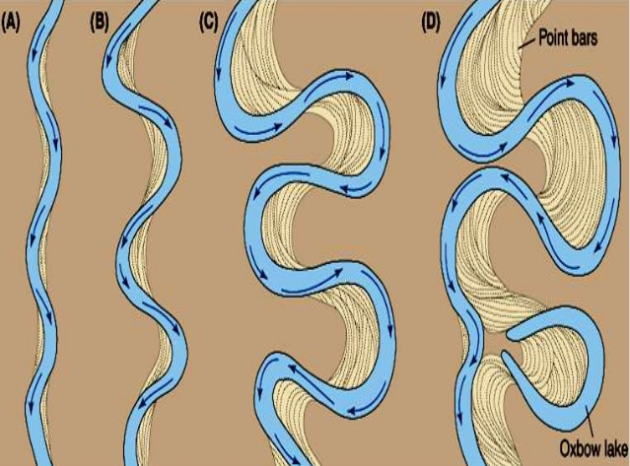During floods, the flood waters down payment fine-grained sediment right into the oxbow lake. Because of this, oxbow lakes tend to end up being filled out with fine-grained, organic-rich debris in time. Throughout reduced circulation problems, straight river channels have bars of sediment on their beds. The running water weaves around these bars of debris which in turn produces deeper pathways where most of the water flows called swimming pools as well as shallow areas where less water flows called riffles. Inevitably, the river circulation begins to turn back and forth.
If the region later undertakes structural uplift, the winding stream will certainly once again return to descending disintegration. The winding pattern will continue to be as a deep valley known as an incised meander. Rivers in the Colorado Plateau as well as streams in the Ozark Plateau are kept in mind for these incised twists.
River Landforms
In both cases, the easy rock erodes, leaving a difficult ledge over which the stream falls. The photo listed below demonstrate how close the neck of the meander is to being breached. At some point, the neck of the meander will be breached by the river developing an ox-bow lake. The airborne photo listed below programs a meander in the River Derwent, North Yorkshire that has actually been recently breached.
- Meanders intensify themselves– the stream often tends to wear down outside of the meander and deposit sediment on the inside.
As in the case of the Anderson Bottom Rincon, incised meanders that have either steep-sided, commonly vertical wall surfaces, are frequently, yet not constantly, called rincons in the southwest USA. Rincon in English is a nontechnical word in the southwest United States for either a little private valley, a niche or angular recess in a cliff, or a bend in a river. In the stability theory, twists reduce the stream slope up until an equilibrium in between the erodibility of the terrain and the transportation capability of the stream is gotten to. A mass of water coming down should surrender possible energy, which, offered the very same speed at the end of the decrease as at the start, is gotten rid of by communication with the product of the stream bed. The fastest distance; that is, a straight channel, leads to the greatest power each of length, interfering with the banks much more, creating more debris and aggrading the stream.
Incised Twists
Meanders are common landforms at the middle and lower courses of a river. Meander gradients are generally more gentle as well as they experience side disintegrations which widen the channel of the river at the middle and reduced programs of a river. Typically, the power coming with circulation water in a river reduces gradually from the upper course of the river to the most affordable course of the river.
As an outcome of this phase, damaging usually takes place on the external financial institution and deposition on the inner bank of the meander. As noted above, it was initially either argued or presumed that an incised meander is characteristic of an antecedent stream or river that had incised its network right into underlying strata. An antecedent stream or river is one that maintains its initial course and also pattern throughout laceration in spite of the changes in underlying rock topography as well as rock types. A meander is among a collection of routine sinuous curves in the network of a river or various other gutter.
The Spatial Plan Of River Systems
Oxbow lakes type when a meander expands so huge and loopy that two bends of the river join together. Once the meander flexes sign up with, the circulation of water decreases and debris begins to build up. In time oxbow lakes will certainly fill with sediment as well as can also vanish. The factor where both bends converge is called a meander cut-off. Where the river swings towards the bank lateral disintegration triggers damaging.
The presence of meanders permits the stream to adjust the length to a stability power each size in which the stream lugs away all the sediment that it generates. Meanders are an outcome of the interaction of water flowing via a curved network with the underlying river bed. This generates helicoidal circulation, in which water relocates from the outer to the inner bank along the river bed, after that flows back to the external financial institution near the surface of the river.
Twist Proportion
Either a river or stream forms a sinuous channel as the outer side of its bends are eroded away as well as debris accumulate on the internal side, which develops a twisting horseshoe-shaped bend. Eventually as the outcome of its winding, the fluvial channel cuts through the narrow neck of the meander and develops a cutoff meander. A meander is a bend in a river, also called an oxbow loophole. A stream or river moving with a broad valley or flat level will certainly often tend to form a winding stream program as it alternatively deteriorates and transfers debris along its program. The result is a snaking pattern as the stream meanders back and forth throughout its floodplain.
The Meander River is south of Izmir, east of the ancient Greek town of Miletus, now Milet, Turkey. It moves with collection of 3 graben in the Menderes Massif, however has a flooding plain much bigger than the meander zone in its reduced reach. The picture below demonstrate how close the nexk of the meander is to being breached. Apart from the most steady meander located in the Gulf Stream, twists are commonly additionally discovered in the other significant western border present systems. As an example, the Kuroshio Current south of Japan exists in one of two stable courses, a zonal path and also a meander path, each lasting for a duration of years. Cut-offs are common functions of incised bedrock twists.